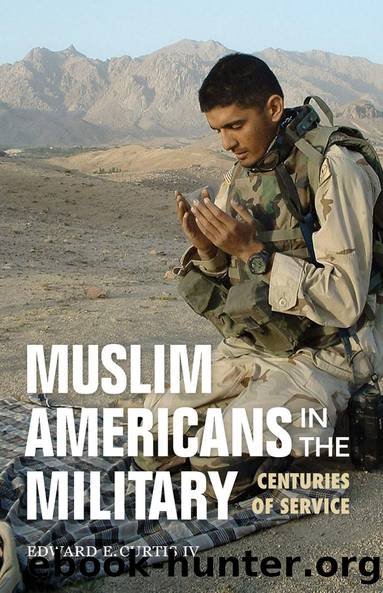Muslim Americans in the Military by Edward E. IV Curtis

Author:Edward E. IV Curtis [Curtis, Edward E. IV]
Language: eng
Format: epub
Tags: History, Military, United States, Social Science, Islamic Studies, Race & Ethnic Relations
ISBN: 9780253027214
Google: QeFKDQAAQBAJ
Publisher: Indiana University Press
Published: 2016-10-17T01:10:06+00:00
Lt. Col. Shareda Hosein served in the US Army and army reserves for more than thirty-five years. (Photo by Bob Croslin.)
In 2007, Hosein became a cultural engagement officer at the US Special Operations Command (SOCOM). Her mission was to educate her colleagues about Islam and Muslims. Since both wars in Iraq and Afghanistan were in the Muslim-majority countries, it was important to her to explain the diversity of Muslims, especially the difference between al-Qaedaâs understanding of Islam and that of almost every other Muslim. Hosein would answer questions about the Qurâan and bring in outside speakers to deliver guest lectures at SOCOM.19
Hosein was also working toward a different job in the military during this time. She wanted to become the first female Muslim chaplain in the military. In 2001, this idea became a calling. She was posted in Kuwait and was hanging out in the base chapel. Another female soldier who had converted to Islam was having trouble performing ablutionsâthe ritual cleansing, generally with water, of the hands, mouth, face, forearms, head, ears, and feetâthat one is supposed to do before making daily prayers. A male Muslim chaplain asked Hosein to help out. The two women went to the bathroom, and Hosein demonstrated how to do the ritual washing. This was the sign that confirmed her heartâs desire to become a chaplain. âI got so choked up,â she said in one interview, âbecause I had prayed to God, asking, âIs this the right thing for me to do?â And I was like: âYou canât get a bigger sign than this. You just canât.â And so I helped her. The man led the prayer. And we prayed.â20
Hosein was already enrolled in Hartford Seminaryâs Islamic chaplaincy program, which would grant her the masterâs degree in divinity generally recognized as a necessary qualification for any chaplaincy, whether in the military or civilian life. In 2003, she submitted her application to the military to become a full-time chaplain. In 2004, while in Kuwait, she met the chief of staff for the armyâs chief of chaplains. As Hosein later recalled, âHe pretty much said, âHey, weâd love to have you. We need you, but you canât lead prayers with men and women. So, you canât come on board.ââ The official was referring to the fact that almost all Muslims understand Sharia, or Islamic law and ethics, as requiring males to lead the prayers when men and women are both in attendance. The army had decided that because Hosein could not perform all of the ritual functions of a male chaplain, she could not become a chaplain in any capacity. The military maintained the same policy for women who wanted to become Roman Catholic chaplains. Because the Roman Catholic Church reserves certain rituals only for male priests, the military figured that it too would hire only male Roman Catholic chaplains.
Hosein said that the military simply misunderstood the role of the imam in Islamic religion. Lt. Col. Abdul-Rasheed Muhammad, the militaryâs first Muslim chaplain, supported her application and hoped that the army would change its mind.
Download
This site does not store any files on its server. We only index and link to content provided by other sites. Please contact the content providers to delete copyright contents if any and email us, we'll remove relevant links or contents immediately.
| Africa | Americas |
| Arctic & Antarctica | Asia |
| Australia & Oceania | Europe |
| Middle East | Russia |
| United States | World |
| Ancient Civilizations | Military |
| Historical Study & Educational Resources |
Machine Learning at Scale with H2O by Gregory Keys | David Whiting(4257)
Never by Ken Follett(3877)
Fairy Tale by Stephen King(3306)
The Man Who Died Twice by Richard Osman(3040)
Oathbringer (The Stormlight Archive, Book 3) by Brandon Sanderson(3010)
Will by Will Smith(2872)
Rationality by Steven Pinker(2326)
The Dark Hours by Michael Connelly(2278)
Can't Hurt Me: Master Your Mind and Defy the Odds - Clean Edition by David Goggins(2270)
Friends, Lovers, and the Big Terrible Thing by Matthew Perry(2179)
The Dawn of Everything: A New History of Humanity by David Graeber & David Wengrow(2155)
Principles for Dealing With the Changing World Order: Why Nations Succeed and Fail by Ray Dalio(2005)
HBR's 10 Must Reads 2022 by Harvard Business Review(1820)
A Short History of War by Jeremy Black(1815)
Go Tell the Bees That I Am Gone by Diana Gabaldon(1730)
A Game of Thrones (The Illustrated Edition) by George R. R. Martin(1659)
515945210 by Unknown(1642)
Kingdom of Ash by Maas Sarah J(1591)
443319537 by Unknown(1520)
